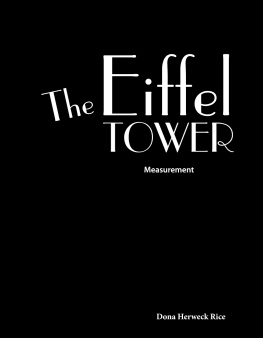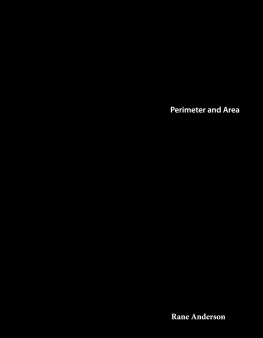Noelle Hoffmeister - Amazing Animals: Venomous Snakes: Fractions and Decimals
Here you can read online Noelle Hoffmeister - Amazing Animals: Venomous Snakes: Fractions and Decimals full text of the book (entire story) in english for free. Download pdf and epub, get meaning, cover and reviews about this ebook. year: 2018, publisher: Teacher Created Materials, genre: Children. Description of the work, (preface) as well as reviews are available. Best literature library LitArk.com created for fans of good reading and offers a wide selection of genres:
Romance novel
Science fiction
Adventure
Detective
Science
History
Home and family
Prose
Art
Politics
Computer
Non-fiction
Religion
Business
Children
Humor
Choose a favorite category and find really read worthwhile books. Enjoy immersion in the world of imagination, feel the emotions of the characters or learn something new for yourself, make an fascinating discovery.
- Book:Amazing Animals: Venomous Snakes: Fractions and Decimals
- Author:
- Publisher:Teacher Created Materials
- Genre:
- Year:2018
- Rating:5 / 5
- Favourites:Add to favourites
- Your mark:
- 100
- 1
- 2
- 3
- 4
- 5
Amazing Animals: Venomous Snakes: Fractions and Decimals: summary, description and annotation
We offer to read an annotation, description, summary or preface (depends on what the author of the book "Amazing Animals: Venomous Snakes: Fractions and Decimals" wrote himself). If you haven't found the necessary information about the book — write in the comments, we will try to find it.
Amazing Animals: Venomous Snakes: Fractions and Decimals — read online for free the complete book (whole text) full work
Below is the text of the book, divided by pages. System saving the place of the last page read, allows you to conveniently read the book "Amazing Animals: Venomous Snakes: Fractions and Decimals" online for free, without having to search again every time where you left off. Put a bookmark, and you can go to the page where you finished reading at any time.
Font size:
Interval:
Bookmark:
0covercover.xhtmlAmazing Animals Venomous Snakes Fractions and Decimals Noelle Hoffmeistercover1page0001page0001.xhtmlMath Talk 1. How are fractions and decimals alike? How are they different? 2. How can you write a fraction as a decimal? 3. How can you use a model to compare decimals? 4. How are tenths and hundredths related? 5. How can you determine whether a fraction and a decimal are equivalent? 6. How can understanding decimals help you in real life?22page0002page0002.xhtmlAmazing Animals Venomous Snakes Fractions and Decimals33page0003page0003.xhtml44page0004page0004.xhtmlTable of Contents Mysterious Venomous Snakes 4 Cunning Cobras 8 Bashful Belcher's Sea Snakes 12 Beastly Black Mambas 15 Incredible Inland Taipans 18 Reluctant Rattlesnakes 23 Venom : Dangerous but Helpful 26 Problem Solving 28 Glossary 30 Index 31 Answer Key 3255page0005page0005.xhtmlMysterious Venomous Snakes Imagine walking through a hot, dry desert in North America. The blazing sun beats down on your body as you walk across the sand. To your left are green cacti covered with spiny needles. To your right, if you look closely, are lizards scurrying across the sand and hiding under rocks for shade. Small birds hop on the sand, chirping and talking to each other. You are grateful to have your water bottle with you on this journey. As you stop to take a drink, you feel the cool liquid on your lips. As you step over a rock, you hear a soft rattle coming from behind you. Immediately, you freeze. You've been warned about this sound. Could it be a venomous snake? Although we don't see them much, it's easy to find venomous snakes. They live on almost every continent in the world. Snakes don't need a lot to survive. Their two main necessities are food and warm weather for part of the year. The maps in this book show where different species of venomous snakes live. Take a look. There may be a species near you!66page0006page0006.xhtmlregions where venomous snakes live77page0007page0007.xhtmlVenomous snakes are any snake species that uses venom, or poison, to capture their prey. The teeth of these snakes are curved inward to help them hold their prey in their mouths. This is one way they've adapted over time. Adaptations are slow changes over thousands of years that help living organisms survive. Most venomous snakes eat small animals, such as rats, mice, lizards, frogs, and birds. They even eat bird eggs. How does a snake capture its meal? First, it bites its prey. As it bites, the snake's venom moves into its hollow, tube-like teeth. The venom in this bite makes its prey stop moving. The venom flows into the body of the prey and paralyzes it. The snake is now ready to eat. It swallows its meal whole! Snakes have a separate lower jaw and strong tendons that help them ingest large food. The digestive system of snakes is so strong that it can break down eggshells and even bones! All around the world, venomous snakes are known for their speed, agility, and dangerous bites. But, each species has specific features that make them unique. compressor muscle venom gland primary venom duct protective sheath secondary venom duct fang venom canal venom88page0008page0008.xhtmlA snake releases venom from its sharp, curved fangs. LET'S EXPLORE MATH Not all snakes in the world have venom. It is estimated that only of snakes are venomous. Draw the number line shown below and label the missing fractions and decimals. Then, plot a point to show. 0 0.1 110 0.5 510 1.0 199page0009page0009.xhtmlCunning Cobras You wouldn't want to run into king cobras in the wild! They are the largest venomous snakes in the world. They can grow up to 18 feet (5 meters) long the same height as 3 adults standing on top of one another! King cobras can weigh up to 20 pounds (9 kilograms) and can live up to 20 years. A king cobra may not have a leg to stand on, but that doesn't stop it from standing tall! It has the ability to lift the front third of its body up to 6 ft. (2 m) off the ground! regions where king cobras live1010page0010page0010.xhtmlKing cobras live in warm places, such as India and Southeast Asia. They can live in water, on land, underground, or in treetops. A distinctive feature of a king cobra is its hood. When it feels scared, it stretches out its neck ribs. At the same time, the cobra hisses. Surprisingly, this sounds like a growling dog! Unlike other venomous snakes, a king cobra's jaws are not very strong. When it bites its prey, the snake chews on it to make sure the venom gets inside the prey's body. A king cobra flares its hood to warn predators.1111page0011page0011.xhtmlKing cobras are very dangerous. Only of the venom in a king cobra's bite is needed to kill a human. Victims of bites have 30 minutes to get help or they may die. Even so, king cobras are not only predators, but they are also prey! The Indian gray mongoose is a predator of the cobra. Cobras hiss and show their hoods when they feel threatened by a mongoose. But, mongooses move quickly as cobras attack. Their thick skin and fur protect them from a cobra's venom. A mongoose will capture a cobra by sinking its teeth into the back of the snake's neck. The Indian gray mongoose wins the duel! Mongooses are not the only threat to cobras. Humans hunt king cobras for their meat, skin, and venom. These things are used in food and medicine. Humans also threaten cobra habitats through deforestation. With fewer places to live, the king cobra population is dropping. This makes it a vulnerable species. Now, there are laws in place to protect king cobras from illegal hunting. People are also working to save their habitats. An Indian gray mongoose attacks a king cobra.1212page0012page0012.xhtmlLET'S EXPLORE MATH Cobras are cunning. They like to sneak up on their prey. They attack in more than one way. Black-necked cobras can spit venom up to 2. 4 meters. If this venom hits your eyes, it can cause permanent blindness! 1. How is 2. 4 written as a fraction? 2. Draw a number line and plot a point to show 2. 4. Between which two whole numbers does 2. 4 fall? How many equal parts are between the whole numbers? a deforested area in India1313page0013page0013.xhtmlBashful Belcher's Sea Snakes Snakes slither on land, right? Well, not this snake! Unlike most venomous snakes, the Belcher's sea snake lives its entire life in water. This reptile lives in the Indian and Pacific Oceans. People rarely see this type of snake. It is considered shy but very dangerous. Compared to a cobra, the Belcher's sea snake is very small. It will only grow to be about 39 inches (1 meter). That's only of the length of a king cobra! The Belcher's sea snake has traits that help it live in water. The snake has valves over its nostrils that close when it's underwater. It can also hold its breath for seven to eight hours, giving the snake plenty of time to find food.1414page0014page0014.xhtmlThe sea snake spends its whole life in water. Its predators live in the water, too. Large fish like tiger sharks hunt and eat the Belcher's sea snake. The Belcher's sea snake is one of the most venomous snakes in the world and is considered 100 times more lethal than any other snake. However, the Belcher's sea snake only releases venom of the time it strikes. It takes only of the venom in one bite to kill a human! Belcher's sea snakes LET'S EXPLORE MATH It takes of the venom in a Belcher's sea snake's bite to kill a human. It takes about of the venom in a cobra's bite to kill a human. 1. Use two hundredths grids to show 1/100 and. 2. Write and as decimals. Compare the decimals using >, <, or =.1515page0015page0015.xhtmlblack mamba regions where black mambas live regions where black mambas live1616page0016page0016.xhtmlBeastly Black Mambas When people see black mambas for the first time, they are often confused. Their bodies aren't black at all. Their bodies are brown, gray, or green. Their color helps them camouflage with their environment. So, where do they get their name? Surprisingly, the name comes from the color inside their mouths. This feature is unique to black mambas. Barely trailing behind cobras in size, black mambas can grow to be 14 ft. (4 m) long. They are Africa's longest venomous snakes. Like king cobras, these snakes can live up to 20 years. Black mambas attack when they feel trapped. They will bite several times to defend themselves, even though one bite is enough to cause death. With each bite, they inject enough venom to kill more than 10 people. In fact, only two drops of their venom is enough to make a person's heart stop beating! Without antivenin, a victim of a bite only has 20 minutes to live. Many of these victims live in areas that are far from hospitals, which makes the situation even more threatening. regions where black mambas live1717page0017page0017.xhtmlBlack mambas might seem scary, but they have their own fears. While black mambas are often found in pairs or small groups, they are no match for predators. Similar to king cobras, mongooses are natural predators of black mambas. Foxes and birds also hunt these venomous snakes. A snake eagle may crush a black mamba with its sharp talons or drop it from high altitudes to kill it. But, the biggest threat to black mambas is humans. People kill black mambas to prevent them from attacking humans. Capturing a black mamba is not an easy task. It is the fastest land snake in the world. It can travel 12 miles per hour (20 kilometers per hour). That's faster than an average human can run. Black mambas use their speed to escape from danger more than to sneak up on prey. They attack people only when threatened or cornered. An animal handler holds a black mamba in South Africa.1818page0018page0018.xhtmlA brown snake eagle grasps a black mamba in its talons. LET'S EXPLORE MATH A scientist measures the speed of a black mamba. Its speed is 20.31 kilometers per hour. 1. Draw the number line shown below. Use it to plot a point showing 20.31. 20 20.1 20.2 20.3 20.4 20.5 20.6 20.7 20.8 20.9 30 2. Between which two decimals does 20. 31 fall? Which of these decimals is closer to 20.31? How do you know?1919page0019page0019.xhtmlIncredible Inland Taipans If you ever find yourself in Australia, be sure to watch your step! You might run into the inland taipan (TI-pan). Some scientists say it is the world's most venomous snake. Scientists often call it the fierce snake. It gets this nickname because of its fatal venom. It is also famous for the way it attacks its prey. Inland taipans rapidly bite their prey many times, although one bite will most likely do the trick! regions in Australia where inland taipans live2020page0020page0020.xhtmlInland taipans are not colorful snakes. They are typically light yellow or dark brown. These colors act as camouflage that helps them stay out of plain sight. Inland taipans also change color based on seasons. During the summer, the lighter color helps them stay cool. During the winter, the darker color helps them absorb the sun's rays to keep warm. Inland taipans are never too hot or too cold! inland taipan2121page0021page0021.xhtmlInland taipans are not aggressive snakes, but they will defend themselves if provoked. They rise in an S-shaped curve. If their warnings are ignored, they will strike! Potent venom is another weapon used by inland taipans. It doesn't take much only of the venom in this snake's bite is needed to kill a human. Inland taipan attacks are ferocious. Similar to black mambas, inland taipans strike multiple times in one attack. They bite quickly and accurately, giving prey no time to fight back. They wait patiently for prey to grow still and die. Then, it's time to eat. inland taipan2222page0022page0022.xhtmlInland taipans have predators, too. Their main predators are king brown snakes. It is not unusual for snakes to eat other snakes. But, king brown snakes are special because they are immune to the venom of inland taipans. This means the venom of inland taipans can't kill king brown snakes. LET'S EXPLORE MATH Only about of the venom in a black mamba's bite is needed to kill a human. Only about of the venom in an inland taipan's bite is needed to kill a human. 1. Write and as decimals in a place value chart similar to the one below. hundreds tens ones tenths hundredths 2. Use the place value chart and >, <, or = to compare the decimals. Explain your reasoning. king brown snake2323page0023page0023.xhtmleastern diamondback rattlesnake regions where rattlesnakes live2424page0024page0024.xhtmlReluctant Rattlesnakes Next stop : North and South America. All 32 types of rattlesnakes call these continents home. These snakes have adapted to survive in many places. Their habitats include mountains, deserts, and plains. Eastern diamondback rattlesnakes are the largest venomous snake in North America. They can grow to be 8 ft. (2 m) long. They can weigh up to 10 lbs. (5 kg). Their main colors are brown and black so they can blend in. Unlike other snakes, they also have distinct yellow and black diamond shapes along their backs. Rattlesnakes have to watch out for predators like kingsnakes. Kingsnakes are immune to rattlesnake venom. They can get close enough to kill a rattlesnake easily. Eagles, hawks, and roadrunners will also attack them. These snakes have to be on the lookout for people, too! Just like black mambas and king cobras, humans are one of the main predators of rattlesnakes. A unique trait of adult rattlesnakes is their ability to control the amount of venom in a bite. Scientists think that they do not want to waste venom. They use their venom only of the time they bite. And, less than half of those bites have the power to kill. BEWARE Rattlesnakes2525page0025page0025.xhtmlWhat sets rattlesnakes apart from other venomous snakes? You guessed it their rattles! The rattle is found on the end of the snake's tail. When a rattlesnake is born, it only has its first rattle segment, or birth button. Each time the snake sheds its skin, it adds another part to the end of its rattle. This makes the rattle longer. It is a myth, however, to think that the length of a rattle tells the age of the rattlesnake. Rattles break and pieces fall off all the time. Also, rattlesnakes shed more than once a year. In fact, a baby rattlesnake may shed as early as two weeks after it is born. For these reasons, it is difficult to tell how old a rattlesnake is by simply looking at its rattle. Rattlesnakes use their rattles to warn potential predators to back away. It sounds similar to a baby's rattle. Interestingly, the rattle is made from keratin, the same material as your fingernails! These snakes don't want to attack people. So if you hear a rattle, back away. You've been warned! rattle older newest segment containing living tissue birth button2626page0026page0026.xhtmlshedded snake skin LET'S EXPLORE MATH A researcher studies the strike speed of two rattlesnakes. She finds that the cottonmouth rattlesnake strikes in 2. 9 milliseconds. The bar Texas rat snake strikes in 2. 6 milliseconds. 1. Draw and shade bar models like these to represent 2.9 and 2.6. 2.9 2.6 2. Compare 2.9 and 2.6 using >, <, or =. Explain your reasoning.2727page0027page0027.xhtmlVenom : Dangerous but Helpful Each type of venomous snake has its own unique traits that set it apart from the rest. But, they all definitely have one thing in common : if they feel threatened, they will bite! There are many myths about what people should do if a venomous snake bites them. But, believing these myths can have deadly results. People should not try to suck the venom out of a bite, put ice on a bite, or take any medicine unless a doctor prescribes it. There are some important things people should do if they are bitten. They should call 9-1-1 right away. If possible, they should try to identify the snake. Then, they can describe it to a doctor. Finally, they should sit or lie still. This way, the venom doesn't spread through their body as quickly. A doctor demonstrates snake bite survival skills in Indonesia by wrapping a boy's arm in a bandage.2828page0028page0028.xhtmlSnake venom can kill, but it can also be helpful to humans. Venom from a king cobra can help people who are in pain. The venom of a pit viper is used to make medicine to help lower people's blood pressure. Scientists are testing snake venom to find out whether it can help people who have cancer. Most will agree that venomous snakes are dangerous, but people can also benefit from them, too! A scientist extracts venom from a viper.2929page0029page0029.xhtmlProblem Solving Suppose you are a herpetologist, a scientist who studies snakes. Your job is to create snake displays for a new reptile exhibit at a zoo. The reptile exhibit has 10 cages that are equal in size. 1. Choose four different types of snakes you read about in this book. Draw a model like the one shown. Then, write the name of each snake in one section of the model. 2. What fraction of the model does each type of snake represent? How can this be written as a decimal? 3. What fraction of the whole exhibit do all of the snakes occupy? How can this be written as a decimal? 4. Is more than or less than of the whole exhibit occupied by snakes? Explain your thinking. Reptile Exhibit3030page0030page0030.xhtml3131page0031page0031.xhtmlGlossary adapted changed so that it is easier to live in a particular place agility ability to move quickly and easily antivenin remedy used to counteract venom camouflage blend into surroundings continent a large land mass on Earth deforestation the act of cutting down or burning all the trees in an area fatal causing death habitats places where plants or animals normally live or grow herpetologist a scientist who studies snakes immune protected from a poison or bacteria ingest to swallow or absorb myth popular belief that is false paralyzes makes incapable of moving predators animals that kill and eat other animals prey animals that are hunted and killed traits qualities that make living things different from one another venom poison venomous any animal that uses venom as a defense vulnerable open to attack3232page0032page0032.xhtmlIndex adaptation, Africa, Asia, Australia, Belcher's sea snake, black mamba, camouflage, habitat, inland taipan, king brown snake, king cobra, Middle East, mongoose, North America, Philippines, predator, rattlesnake, scientists, South America, species, venom,3333page0033page0033.xhtmlAnswer Key Let's Explore Math page 7 : 0 0.1 0.2 0.3 0.4 0.5 0.6 0.7 0.8 0.9 1.0 1 page 11 : 1. 2.4 = 2 or 2 2. Between 2 and 3; 10 equal parts page 13 : 1. 1 part for and 5 parts for should be shaded 2. = 0. 01; = 0.05; 0.01 < 0.05 or 0.05 > 0.01 page 17 : 1. 20.31 should be labeled slightly to the right of 20.3 2. Between 20.3 and 20.4; 20.31 is closer to 20.3; Answers will vary. page 21 : 1. = 0. 1; = 0.01 2. 0.1 > 0.01 or 0.01 < 0.1; 0.1 has more tenths so it is greater than 0.01. page 25 : 1. For 2. 9, 2 wholes and 9 of the 10 parts should be shaded. For 2. 6, 2 wholes and 6 of the 10 parts should be shaded. 2. 2. 9 > 2. 6 or 2. 6 < 2. 9; 9 tenths is greater than 6 tenths, so 2. 9 is greater than 2. 6. Problem Solving 1. Answers will vary. 2. ; 0.1 3. ; 0.4 4. Less than ; Answers will vary, but should include that < and =, so <.3434page0034page0034.xhtmlMath Talk 1. How are fractions and decimals alike? How are they different? 2. How can you write a fraction as a decimal? 3. How can you use a model to compare decimals? 4. How are tenths and hundredths related? 5. How can you determine whether a fraction and a decimal are equivalent? 6. How can understanding decimals help you in real life?3535page0035page0035.xhtmlAmazing Animals Venomous Snakes Fractions and Decimals Watch your step! You are entering the mysterious world of venomous snakes. Whether these reptiles live on land or in the sea, their venom can kill. Learn to express fractions and decimals as you explore these cold-blooded creatures. Fractions and Decimals36
Next pageFont size:
Interval:
Bookmark:
Similar books «Amazing Animals: Venomous Snakes: Fractions and Decimals»
Look at similar books to Amazing Animals: Venomous Snakes: Fractions and Decimals. We have selected literature similar in name and meaning in the hope of providing readers with more options to find new, interesting, not yet read works.
Discussion, reviews of the book Amazing Animals: Venomous Snakes: Fractions and Decimals and just readers' own opinions. Leave your comments, write what you think about the work, its meaning or the main characters. Specify what exactly you liked and what you didn't like, and why you think so.













